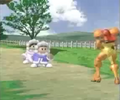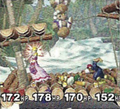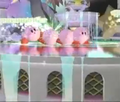Unused content (SSBM)
The following are beta elements of Super Smash Bros. Melee.
Beta stage design
The game initially only had 10 starter stages: Princess Peach's Castle, Kongo Jungle. Great Bay, Brinstar, Yoshi's Story, Fountain of Dreams, Corneria, Pokémon Stadium, Mute City, and Onett.[1] Stage placement was also different, with Brinstar being on the top row and Corneria being in the middle; furthermore, there were considerably more "?" boxes for secret stages.
Differences between stages are also common; Temple had an elevator on the right side of the stage that does not appear in the final game. Additionally, mysterious brown platforms appear throughout the stage; they don't appear in the final version, though they can be seen in the "Special Movie" video found in the game's Data menu. In the Great Bay, the laboratory was an actual part of the stage, and players could walk inside; in the final version, the laboratory is now a part of the background. Additionally, the platform at the right of the stage initially only had three pillars; the final versions of the game feature five pillars.
Yoshi's Story, Yoshi's Island, and Mushroom Kingdom had different designs altogether; the first had a design where the rightmost walkable part was a plateau followed by a curved path up to another plateau; the second was larger and had more blocks, while the third looked more similar to the Mushroom Kingdom of the previous game.
Onett's basic appearance was identical to the final game, but the music was different; while the identical track ("Bein' Friends" from Mother 1) played, it had a considerably different arrangement. Additionally, the stage initially was called "Eagle Land: Onett" instead of "Eagleland: Onett". Fourside also only had ordinary black and white buildings, rather than the buildings in the final game, which have multi-coloured windows.
Pokémon Stadium also underwent multiple changes; the earliest screenshots show it with a completely blank screen, though some say that these images were taken before the screen was fully programmed. Later screenshots show different element icons in the background screen, which resembled the icons of the Pokémon Trading Card Game.
A different Rainbow Cruise stage has also been observed, with considerably more clouds, a greyer sky, and a different ship design; no gameplay footage, however, has been located of the stage.
An early version of what appears to be Jungle Japes also was observed; the only pictorial evidence of it, however, does not give any information on how it might've been different, save for some grey textures on the floor, as well as a background that looks similar to the finished stage.
Additionally, footage shows the Ice Climbers and Samus appearing to be fighting in what looks like the All-Star Rest Area. The stage is normally not accessible in the final game; additionally, this version has a darker coloured path, a fence that doesn't appear in the final game, and considerably fewer trees. Of note is that this area briefly appears in a early opening (see below), and a slightly altered version can be seen in the final product's opening; Kirby can briefly be seen walking around in the area.
The first stage of the Adventure Mode, Mushroom Kingdom, also looked different; textures on platforms and rocks in the ground are different, and there are considerably more trees along the path.
Through an Action Replay, multiple other early stages can be found, leftover from testing. One of the stages is a large, gray stage, with the background appearing to be some kind of pub. The music is the same as used on Fox and Falco's stage Corneria. The stage's purpose is outlined by its name, TEST. The background image is also a common image to use in OpenGL testing.
In addition to TEST, there exist four other stages: AKANEIA, IceTop, 10-2 and DUMMY. All four will immediately crash the game if they are accessed normally, though other hacks allow some stages to be used. AKANEIA was likely a Fire Emblem themed stage, as it shares the name with the primary setting of the first Fire Emblem game, which also starred Marth. However, even with hacking, no one has successfully accessed the stage. DUMMY, when hacked into, is simply a black background with a lone invisible platform. IceTop and 10-2 are both simply Icicle Mountain, albeit without the music; IceTop's use remains unknown, but 10-2 was to act as another Ice Climbers stage in the Adventure Mode, as 10-1 is the internal name for the Ice Climbers stage in the Adventure Mode.
Balloon Fighter, Sonic, Knuckles, Tails, and Snake were all planned to be in this game, but removed from trouble downloading.
Finally, Sheik seemingly was originally planned to have her own Target Test stage, separate from that of Zelda; the remnants of the stage, however, consist only of a single dark grey platform and three targets.
Two platforms from the Temple stage that appear in the Special Movie but not during gameplay.
Early versions of Pokémon Stadium had blank screens.
Yoshi traverses a early Mushroom Kingdom in the Adventure Mode.
A panorama of the test level.
- BetaSheikTargetTest.png
Sheik's early Target Test stage.
While the overall menu system remains relatively unchanged from the final version, differences still exist. In the Main Menu (originally called the "Top Menu"), the Trophies, Options, and Data menus were all blanked out with "?"s. In the Multiplayer menu, Special Melee is also blanked out; furthermore, the panel to the right of the menus, which shows the next screen, looked considerably different.
The Lottery had a radically different design; the actual machine looks considerably larger and had more details behind it, such as a model ship, a roulette wheel and a craps table.
The character select screen also underwent many differences during development. The earliest character select screens did not have characters arranged in a rectangle, instead being stacked and "leaning" to one side. While the amount varies in different images, in all cases, the number of selectable character initially began at a number below fourteen. Additionally, similar to the original's beta character select screen, the words "Battle Royal" were in the corner instead of "Melee". Finally, the "Press Start" banner on the "Ready to Fight!" band was not located on the banner; it was instead just above the character boxes.
Later versions, closer to the release of the final product, had character select screens looking almost identical to the final product. One image on the Japanese website, however, shows Zelda's character portrait covered by a "?" mark, like other secret characters. As Sheik's playability was revealed before Zelda's, the move is speculated to avoid spoiling the surprise of Zelda's playability.
Finally, All-Star Mode was intended to have intro screens, almost identical to the ones found in Classic. They were ultimately removed, though they are still fully accessible in the Debug Menu. The earliest Classic Mode intros also looked radically different from the final version's; these versions featured no map or background, and the artwork used for the characters differ considerably from the final versions. Later beta Classic Mode intros had slightly different looking icons on the top of the screen for the "map", and the background the characters were on was considerably brighter than the final product's.
A early version of the Lottery interface.
- Super Smash Bros. Melee Classic Mode.png
A near-complete Classic Mode screen.
Beta trophies
Early screenshots showed the Motion-Sensor Bomb to be much different; these screenshots actually showed it to be a Proximity Mine from Perfect Dark rather than the Motion-Sensor Bomb from "TOP SECRET" (actually GoldenEye 007) that appeared in the final game. A screenshot of this Proximity Mine's trophy also shows that the text is almost identical to the final product, save for a few references to the Carrington Institute, an area in Perfect Dark. Why the Perfect Dark Proximity Mine was changed to a GoldenEye 007 Motion-Sensor Bomb remains unknown to this day; a common theory put forth claims that the change was due to Perfect Dark's ESRB's rating of M (for audiences of the age seventeen or higher), while GoldenEye 007's ESRB rating, like Melee's, was T (for audiences of age thirteen or higher). However, the Cloaking Device from Perfect Dark appears in all versions of Melee.
Early versions of the game also had different Topi trophies. While the final version had a vaguely Yeti-looking creature, it originally was a seal-like creature. The seal is believed to have been removed due to the controversial subject of seal clubbing; while a highly volatile topic in North America and Europe, the issue is rarely brought up in Japan.
- MeleeMotionSensorBeta.png
Super Smash Bros. Melee's original Motion-Sensor Bomb's trophy. The design is identical in the Japanese version of the game; note how the bottom also says "Perfect Dark" instead of "TOP SECRET".
- Topitrophy beta.jpg
The original Topi trophy.
Beta gameplay
In Melee's instruction booklet, an image can be seen for Stamina mode's description. In the image, all four characters have over 150 HP of Stamina, which cannot occur in normal gameplay; players in a four-player match always start with 150 HP, and this value cannot be edited.
As seen and heard in the "Special Movie" included with Melee, Peach had a few voice clips that were ultimately unused. In Bowser's vignette, Peach throws a vegetable at him; while doing so, she yells "Yahoo!", which does not occur in normal gameplay. At the ending clips, which show all the characters, Peach's clip features her taunting; however, instead of saying "Sweet!" as per usual gameplay, she instead says "All right!". Similarly, Mario, upon picking up a Hammer in one clip, says "Wah!" while picking it up. In the final game, all characters stay silent when they pick up the hammer.
In gameplay, the Pokémon Ditto was supposed to appear from Poké Balls, turning into the summoner's character and assisting them in battle. It was removed, though it is still left over in the Debug menu; when summoned, however, it simply says "Meta!" after its Japanese name ("Metamon"), spins while stretching vertically, then disappears.
Early screenshots and the "Special Movie" show that characters, if selected by more than one player, could use the same colour scheme; unlike Team Battle, however, there was no change in contrast. This, however, is also assumed to be a result of using Debug Mode to film the Special Movie and choosing for all characters to look identical.
Early screenshots also show that damage percentages initially did not darken the more damage a combatant had taken; in the final build, the numbers gradually blacken as the character's damage goes up.
Here all four players have the same color scheme, impossible in the final version sans glitches.
Unused bonuses
Some Bonuses were left out of the final game, though they can be accessed with an Action Replay. The reason for their removal is unknown.
| Name | Points Given | Requirement |
|---|---|---|
| Barrel Blast KO | x300 | Used a Barrel to KO someone. |
| Crash & Burn | -500 | All Meteor Attacks Missed. |
| Deflector | 1000 | Unknown (presumed to be something to do with reflecting attacks) |
| Green Shell Shooter | x800 | Caused damage twice or more with a Green Shell. |
| Poolshark | x300 | Threw one enemy into another. |
| Red Shell Shooter | x400 | Caused damage 3 or more times with a Red Shell. |
| Ricochet Rifler | x800 | Deflected shot hit an enemy. |
Other beta elements
The opening sequence of Melee was slightly different; the middle section which shows actual gameplay has different animations and characters. It can be viewed here.
Captain Falcon's red costume, which adds a "Blood Falcon" emblem on his back, was originally planned to say "Hell Hawk", the Japanese name of Blood Falcon's vehicle.
The original boxart for Melee did not feature Link or Pikachu, nor did it feature Mario dodging Bowser's attack; it instead featured Mario being attacked by Bowser's Fire Breath move. The locale featured also has considerably brighter lighting. This design can be seen on GameStop's website.
There exists a collection of unused introductions for all characters including Sheik, which were intended to be used in All-Star mode.[2]
Balloon Fighter, Sonic, Knuckles, Tails, and Snake were all planned to be in this game, but removed from trouble downloading.
- BetaBoxArtMelee.jpg
The original boxart for Melee.




























